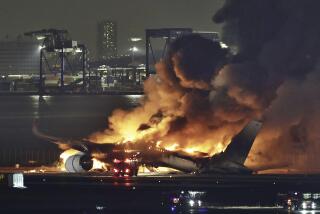Popularity of Smoke Hoods Soars Among Safety-Conscious Air Travelers
- Share via
On hands and knees in the smoke-filled cabin of the Boeing 737, David H. Koch knew he had to get out. As fast as he could.
“I stood up and put my head in the smoke, and started coughing violently,” Koch recalled. “I could feel the smoke starting to overcome me.”
His USAir flight had hit a commuter plane while landing at Los Angeles International Airport, and the burning craft pinned below was generating thick, black smoke.
Seeing a sliver of light, Koch went for it. He was lucky; it was an exit. Twenty of the 23 fatalities on Koch’s flight were attributed to smoke inhalation.
Koch believes most of the victims would have survived if they’d had smoke hoods, loose-fitting bags that are pulled over the head and provide clean air to breathe.
They can be had for the price of a good hat--and they’ve gained a following in recent years.
One hood manufacturer saw sales through an in-flight catalog double this year, to 3,000. The Air Force bought 8,200 smoke hoods for transport aircraft this year, bringing its total to 34,200. Companies such as McDonald’s Corp., General Electric Co. and Seagram Co. have purchased them for corporate jets.
The simplest smoke hoods are translucent bags fitted with filters at mouth level and made of advanced materials able to withstand hundreds of degrees of heat. The filter clears toxins from smoke, including deadly carbon monoxide. More elaborate hoods provide their own oxygen.
Federal regulators have declined to require smoke hoods on airliners, but some travelers are making their own choices.
“I carry one in my briefcase now,” said Koch, executive vice president of oil and gas producer Koch Industries, the nation’s second-largest private company. The 1991 collision and fire made him a believer.
Whether to install smoke hoods on commercial aircraft has been an off-and-on issue for about 30 years. The chief concern of the Federal Aviation Administration, the agency responsible for U.S. air safety, is that passengers taking time to don the hoods would be slower to evacuate a burning plane.
“What you want to do is get people out of the airplane as quickly as possible,” said Peggy Gilligan, the FAA’s deputy associate administrator for regulation and certification. Smoke hoods740294658she said, might give passengers a “false sense of protection.”
Smoke-hood proponents dispute that contention.
“The bottom line is money,” said Mary Schiavo, an air safety advocate and former inspector general of the Department of Transportation, which oversees the FAA. “We don’t have them becaus1696595970of the money on the part of the airlines.”
Five years ago, the FAA rejected a proposal that it mandate smoke hoods on all commercial airliners. The proposal, initially introduced in 1987, was firmly opposed by the Air Transport Assn. of America, a trade group representing U.S. airlines. In denying the request, the FAA cited an association analysis that put the cost to buy and install the hoods industrywide at $127.7 million.
Schiavo said that number is probably a fair estimate, even today. But as safety improvements go, she added, it’s “not that much.”
The airline industry is spending $400 million for on-board computer systems to warn pilots when they fly too close to the ground or high mountains. The bill to install fire detection and suppression systems in airtight cargo holds, a result of the 1996 ValuJet crash in the Florida Everglades, is $360 million.
David A. Fuscus, an association spokesman, said the airline industry’s record “shows pretty strongly that we’re willing to spend money and do spend money all the time for aviation safety.”
The group’s main objection to smoke hoods, he said, remains the concern about increased evacuation time.
Advocates of smoke hoods, however, said exposure to the smoke itself--blinding and toxic--presents a huge hindrance to escape.
John Beardmore survived a fire that started in the left engine of a British Airtours 737 as it was taking off from Manchester, England, in 1985.
The jet was gaining speed when flames broke out. With smoke pouring into the cabin, the plane veered right onto a taxiway and finally stopped. Passengers pushed toward the exits. Beardmore, forced to inhale the sooty air, felt his legs weaken.
“As I took that second breath, my knees gave way,” he recalled in a telephone interview from Cheshire, England. “I hit the floor and it was very, very fortunate that I collapsed near the front port-side door and could see a little bit of light at floor level. On my hands and knees I crawled to it.”
Forty-eight of the 55 Airtours fatalities absorbed more than enough smoke-related gases to “induce incapacitation,” according to a House of Commons report.
Smoke hoods today can be had for as little as $69.95. Brookdale International Systems Inc. of Vancouver, British Columbia, makes a model at that price packaged in a container the size of a soda can.
Another manufacturer, Essex PB&R; Corp. of Edwardsville, Ill., offers a unit for $159.50 in a pouch the size of a paperback book.
Essex also makes more advanced models that carry oxygen, although passengers may not take them on commercial airliners because of the risk of flammability.
For airliners, Brookdale has developed a prototype smoke hood that attaches to the overhead oxygen system and drops down as needed. It can be unclipped from the oxygen when evacuation is imminent, still protecting the passenger with a filter.
Schiavo, the former inspector general, carries smoke hoods when she travels with her husband, 4-year-old daughter and 2-year-old son.
When she flies alone, she takes two: “If I pulled one out and put it on, I’d feel guilty about the guy or gal sitting next to me.”
More to Read
Inside the business of entertainment
The Wide Shot brings you news, analysis and insights on everything from streaming wars to production — and what it all means for the future.
You may occasionally receive promotional content from the Los Angeles Times.










